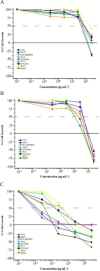Antiglycation and antitumoral activity of Tribulus terrestris dry extract
- PMID: 34046319
- PMCID: PMC8140216
Antiglycation and antitumoral activity of Tribulus terrestris dry extract
Abstract
Objective: Investigation of the antiglycation and antitumoral potential of standardized and saponins-enriched extracts of Tribulus terrestris herbal medicine.
Materials and methods: The procedures for the evaluation of the antiglycation activity of the standardized (TtSE) and saponins-enriched (TtEE) extracts of T. terrestris were: determination of relative mobility in electrophoresis (RME), free amino groups using OPA method and advanced glycation end-products (AGEs) fluorescence. Antioxidant activity was determined by DPPH radical scavenging test. In vitro antitumor activity of TtSE and TtEE was evaluated in human tumor cell lines.
Results: The results were obtained by antiglycation tests (RME, OPA method and AGEs fluorescence determination), using BSA as protein and ribose as glycation agent, and antioxidant assay (DPPH test); it was verified that both extracts of T. terrestris have antiglycation and antioxidant activity. In addition, the extracts were able to induce death of more than 50% of human tumor cell lines.
Conclusion: The present study showed that standardized and saponins-enriched extracts of T. terrestris herbal medicine present antiglycation and antioxidant and antiproliferative action in human tumor cells lines. The saponins-enriched extract proved a greater antiglycation and antioxidant activity in comparison to the standardized type.
Keywords: Antiproliferative; Protein glycation; Steroidal saponins; Tribulus terrestris.
Figures






Similar articles
-
Antiglycation and antioxidant activities of the crude extract and saponin fraction of Tribulus terrestris before and after microcapsule release.J Integr Med. 2022 Mar;20(2):153-162. doi: 10.1016/j.joim.2021.12.003. Epub 2021 Dec 16. J Integr Med. 2022. PMID: 34996732
-
Antioxidant and antiglycation properties of total saponins extracted from traditional Chinese medicine used to treat diabetes mellitus.Phytother Res. 2008 Feb;22(2):228-37. doi: 10.1002/ptr.2297. Phytother Res. 2008. PMID: 17886226
-
Optimization of ultrasound extraction of Tribulus terrestris L. leaves saponins and their HPLC-DAD-ESI-MSn profiling, anti-inflammatory activity and mechanism in vitro and in vivo.J Ethnopharmacol. 2021 Oct 5;278:114225. doi: 10.1016/j.jep.2021.114225. Epub 2021 May 24. J Ethnopharmacol. 2021. PMID: 34038799
-
Tribulus terrestris and female reproductive system health: A comprehensive review.Phytomedicine. 2021 Apr;84:153462. doi: 10.1016/j.phymed.2021.153462. Epub 2021 Jan 8. Phytomedicine. 2021. PMID: 33602600 Review.
-
Role of Tribulus terrestris in Male Infertility: Is It Real or Fiction?J Diet Suppl. 2018 Nov 2;15(6):1010-1013. doi: 10.1080/19390211.2017.1402843. Epub 2017 Dec 20. J Diet Suppl. 2018. PMID: 29261340 Review.
Cited by
-
In vitro evaluation of immunomodulatory, anti-diabetic, and anti-cancer molecular mechanisms of Tribulus terrestris extracts.Sci Rep. 2022 Dec 28;12(1):22478. doi: 10.1038/s41598-022-26742-6. Sci Rep. 2022. PMID: 36577761 Free PMC article.
-
The effect of Tribulus terrestris supplementation on inflammation, oxidative stress, and performance of recreational runners: study protocol for a randomized placebo-controlled trial.Trials. 2022 Aug 19;23(1):689. doi: 10.1186/s13063-022-06630-0. Trials. 2022. PMID: 35986353 Free PMC article.
References
-
- Abraham J, Staffurth J. Hormonal therapy for cancer. Medicine. 2020;48:103–107.
-
- Akbal O, Vural T, Malekghasemi S, Bozdoğan B, Denkbaş EB. Saponin loaded montmorillonite-human serum albumin nanocomposites as drug delivery system in colorectal cancer therapy. Appl Clay Sci. 2018;166:214–222.
-
- Angelova S, Gospodinova Z, Krasteva M, Antov G, Lozanov V, Markov T, Bozhanov S, Georgieva E, Mitev V. Antitumor activity of Bulgarian herb Tribulus terrestris on human breast cancer cells. J BioSci Biotech. 2013;2:25–32.
-
- Anis MA, Sreerama YN. Inhibition of protein glycoxidation and advanced glycation end-product formation by barnyard millet (Echinochloa frumentacea) phenolics. Food Chem. 2020;315:126–265. - PubMed
-
- Bansode SB, Gacche RN. Glycation-induced modification of tissue-specific ECM proteins: A pathophysiological mechanism in degenerative diseases. Biochim Biophys Acta. 2019;1863:129411. - PubMed
Publication types
LinkOut - more resources
Full Text Sources
